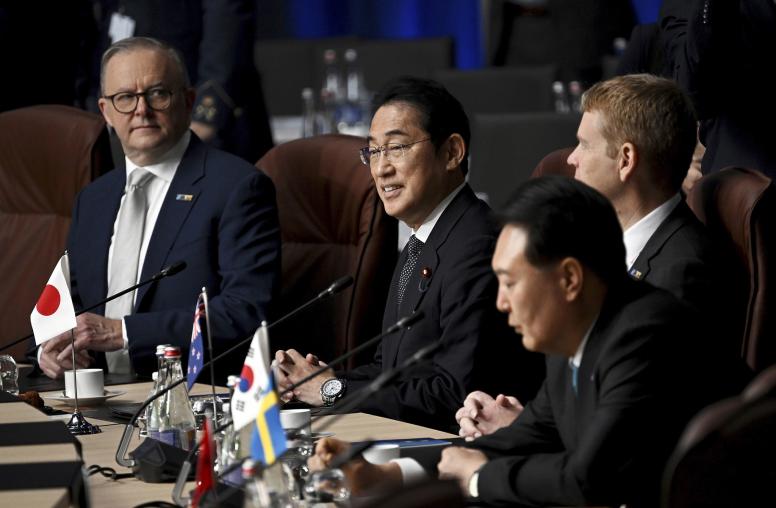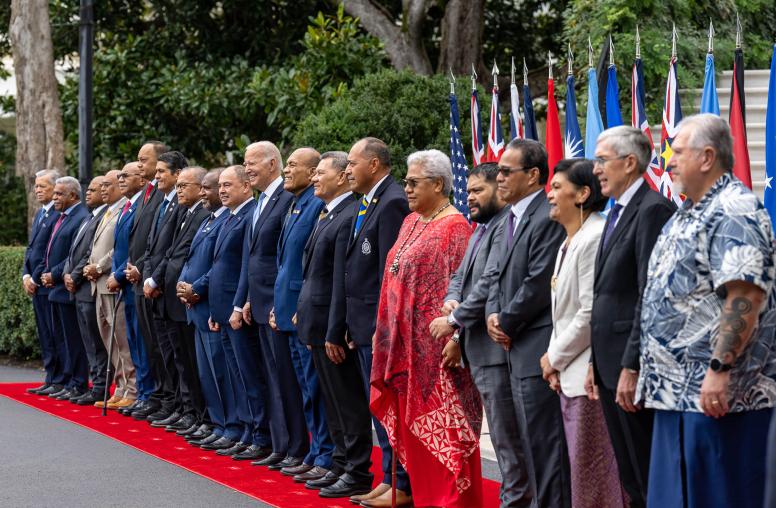What the Quad Leaders’ Summit Means for the Indo-Pacific Amid Rising Tensions with China
USIP experts weigh in on how the growing partnership affects regional economic, diplomatic and security dynamics
On September 24, President Biden hosted Australian Prime Minister Scott Morrison, Indian Prime Minister Narendra Modi and Japanese Prime Minister Yoshihide Suga at the White House for the first-ever in-person Quad Leaders’ Summit. The event marked a milestone for the group, which started as an ad hoc coordination mechanism for humanitarian assistance and disaster relief after the 2004 Indian Ocean tsunami. The four leaders unveiled a slate of new initiatives on a range of pressing global issues — from climate change and COVID-19 to technology, infrastructure and education — as well as formalized plans to meet annually. USIP’s Carla Freeman, Brian Harding, Daniel Markey, Mirna Galic and Vikram Singh consider international reactions to the Quad and implications for the Indo-Pacific region.

Is the Quad a nascent alliance to counter China in the Indo-Pacific?
Freeman: Although the Quad’s joint statement does not mention China, the initiatives and commitments it presents — including on vaccine diplomacy, infrastructure development, North Korean denuclearization and Afghanistan — make clear that the Quad intends to pursue a multifaceted agenda in the Indo-Pacific and beyond that competes with the economic, diplomatic and hard security capabilities wielded by Beijing. The Quad’s emphasis on “shared security and prosperity,” “shared values” and “shared futures” notably takes on Xi Jinping’s campaign to position China as a leader in an international effort to build “a community with a shared future for mankind.”
Markey: Of the four Quad members, India has always been uncomfortable with the idea of framing the Quad as a “counter-China” group, despite its still-unresolved border dispute with China that turned bloody in the summer of 2020. Moreover, India is generally averse to formal security alliances. Still, New Delhi is keen to show how cooperation with Quad partners can pay off in practical ways for the region and to engage in a “positive sum,” non-military competition with China that shows off India’s strengths, such as vaccine production.
Singh: The Quad foreshadows a steady, pragmatic and forward-looking focus on the region.
China is conspicuous in its absence from the Quad Leaders’ Statement, which focuses on things that even Beijing would be hard-pressed to reject — like a billion COVID vaccine doses for the region and a green shipping network. The heart of the Quad is four like-minded nations’ commitment to specific actions and an expectation that, by working together, they can deliver attractive alternatives to sometimes worrisome Chinese investments.
The sharper edge of competition, and the Quad’s strategic place in American thinking, is evident in the technology initiatives like supply chain and network security and in areas that went from passing mentions in March to concrete actions last week: infrastructure and cybersecurity. Two entirely new areas of cooperation — space and development of the next generation with Quad fellowships — also suggest that these four leaders intend to give their Chinese counterparts a lot to think about.<
How has China reacted to the Quad summit?
Freeman: After harsh condemnation of the recently concluded AUKUS security pact, China’s state-run media strikingly downplayed the outcomes of last week’s Quad meeting. A prominent editorial in the Chinese Communist Party's People's Daily did not mention the Quad, instead condemning U.S. "hegemonic anxiety," while also stating that stable U.S.-China relations were in "the fundamental interests of the two peoples." With domestic focus on Huawei executive Meng Wanzhou's return to China and the opportunity for diplomacy that Meng's release (along with the return of both Michael Kovrig and Michael Spavor to Canada) could present, Beijing may have chosen to delay a formal statement on the summit.
How did this Quad Leaders’ Summit advance Japan’s regional foreign policy?
Galic: Japan has deftly translated many of the priorities from its bilateral meetings with the United States in April to the Quad’s multilateral context. Promoting a free and open Indo-Pacific vision and strengthening U.S.-Japan cooperation are core tenets of Japan’s regional foreign policy and the Quad promotes both, so Japan benefits from the elevation of the grouping and the decision to regularize summit meetings. Japan will also be pleased that the Quad statement highlighted the issues of abductions of Japanese citizens by North Korea, maritime challenges in the East China sea (home to the Japanese-administered and Chinese-claimed Senkaku islands), Japan’s COVID-19 emergency support loan and quality infrastructure.
Although the summit marks Suga’s last trip abroad as prime minister, with Liberal Democratic Party leadership elections set for the end of the month, his participation sends the message that Japan’s commitments to Quad initiatives will remain rock solid, regardless of the coming leadership change.
What did Prime Minister Modi hope to gain from his participation in the Quad?
Markey: Prime Minister Modi’s participation in the Quad capped a marathon week of diplomacy that also included bilateral meetings with President Biden and Vice President Kamala Harris, interactions with CEOs from five top U.S. firms and a speech before the U.N. General Assembly. Modi’s trip was intended to turn the page from a disastrous pandemic year, and India’s primary contribution to Quad activities in the near term will be its resumption of vaccine production for export starting next month. India will also be pleased that the Quad leader’s statement included tough language on Afghanistan, which New Delhi fears will turn into a safe haven for Pakistan-backed anti-Indian terrorist groups as it was in the 1990s.
How did Southeast Asia view the summit?
Harding: Southeast Asian countries watched the Quad summit with both hope and wariness. With COVID-19 and its economic fallout still the dominant challenges facing Southeast Asia, the region is watching closely whether the Quad will deliver on its vaccine pledges. India’s assurance that exports will begin soon was welcome news, but timely action will be essential to demonstrating that the Quad can truly deliver public goods that matter to the region. Likewise, the Quad’s infrastructure plans were welcomed with lingering skepticism that the Quad countries can be nimble enough to meaningfully enhance infrastructure development cooperation.
What does the further development of the Quad mean for ASEAN and Europe?
Harding: While interested in the public goods that the Quad aspires to deliver, Southeast Asian leaders are concerned that the development of the Quad will supplant ASEAN’s central role in regional affairs, leading to further deterioration of U.S.-China relations. Quad leaders demonstrated that they understand ASEAN’s concern about its primacy by highlighting support for ASEAN centrality in the joint statement, but concerns will persist. One important way to assuage ASEAN wariness will be to develop linkages between Quad working groups and ASEAN bodies working on the same issues.
Galic: The Quad leaders’ joint statement twice references cooperation with Europe — a much needed salve after the previous week’s fallout from the AUKUS submarine deal and the perceived overshadowing of the European Union’s release of its strategy for cooperation in the Indo-Pacific. This may not be much in the way of emphasis, but it’s a clear departure from the previous Quad leaders’ joint statement in March, which did not include any mention of Europe.



